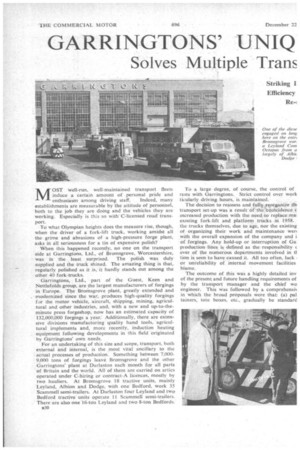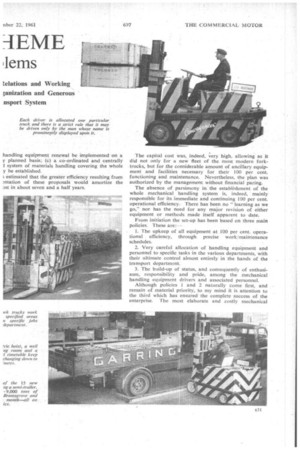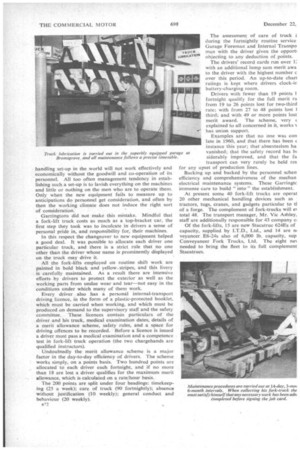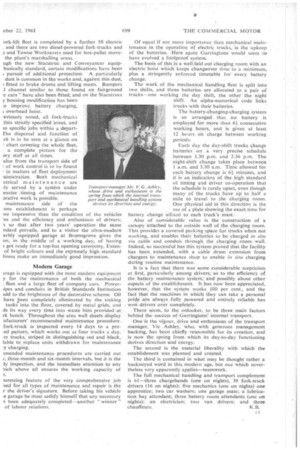GARRINGTONS' UNIQ
Page 34

Page 35

Page 36

Page 37

If you've noticed an error in this article please click here to report it so we can fix it.
--IEME Solves Multiple Trans
"ems
MOST well-run, well-maintained transport fleets induce a certain amount of personal pride and
enthusiasm among driving staff. Indeed, many establishments are measurable by the attitude of personnel, both to the job they are doing and the vehicles they are working. Especially is this so with C-licensed road transport.
To what Olympian heights does the measure rise, though, when the driver of a fork-lift truck, working amidst all the grime and abrasions of a high-pressure forge plant, asks in all seriousness for a tin of expensive polish?
When this happened recently, no one on the transport side at Garringtons, Ltd., of Bromsgrove, Worcestershire,
was in the least surprised. The polish was duly supplied and the truck shined. The amazing thing is that, regularly polished as it is,it hardly stands out among the other 40 fork-trucks.
Garringtons, Ltd., part of the Guest, Keen and Nettlefolds group, are the largest manufacturers of forgings in Europe. The Bromsgrove plant, greatly extended and • modernized since the war, produces high-quality forgings for the motor vehicle, aircraft, shipping, mining, agricul tural and other industries, and, with a new and up-to-the minute press forgeshop, now has an estimated capacity of 132,000,000 forgings a year: Additionally, there are exten
sive divisions manufacturing quality hand tools, agricultural implements and, more recently, induction heating equipment following developments in this field -originated by Garringtons' own needs.
For an undertaking of this size and scope, transport, both external and internal, is the most vital ancillary to the -actual processes of production. Something between 7,0009,000 tons of forgings leave Bromsgrove and the other Garringtons' plant at Darlaston each month for all parts of Britain and the world. All of them are carried on artics operated under C-hiring or contract-A licences, mostly by two hauliers. At Bromsgrove 18 tractive units, mainly Leyland, Albion and Dodge, with one Bedford, work 35 Scammell semi-trailers. At Darlaston four Leyland and two
Bedford tractiveunits operate 11 Scammell semi-trailers. There are also one .16-ton Leyland and two 8-ton Bedfords. 530
To a large degree, of course, the control of rests with Garringtons. Strict control over work ticularly driving hours, is maintained.
The decision to reassess and fully reorganize *hi transport set-up was a result or thel.t4iticidence c increased production with the -need-to-replace ma: existing fork-lift and platform trtieks in 1958. the trucks themselves, due to age, nor the existing of organizing their work and maintenance wen with the overall expansion of. the company and i -of forgings. Any hold-up or interruption of Ga; pioduction lines is defined as the responsibility ever of the numerous departments involved in ti tion is seen to have caused it. All too often, lack or unreliability of internal movement facilities blame.
The outcome of this was a highly detailed inv of thepresent and future handling requirements of by the transport manager and the chief wo engineer. This was followed by a cornprehensiN in which the broad proposals were that: (a) pal tainers, tote boxes, etc., gradually be standard handling equipment renewal be implemented on a y planned basis; (c) a co-ordinated and centrally I system of materials handling covering the whole y be established.
; estimated that the greater efficiency resulting from mtation of these proposals would amortize the ast in about seven and a half years. The capital cost was, indeed, very high, allowing as it did not only for a new fleet of the most modern forktrucks, but for the considerable amount of ancillary equipment and facilities necessary bar their 100 per cent. functioning and maintenance. Nevertheless, the plan was authorized by the management without financial paring.
The absence of parsimony in the establishment of the whole mechanical handling system is, indeed, mainly responsible for its immediate and continuing 100 per cent. operational efficiency.There has been no learning as we go," nor has the need for any major revision of either equipment or methods made itself apparent to date.
From initiation the set-up has been based on three main policies. These are:- 1. The upkeep of all equipment at 100 per cent. operational efficiency, through precise work/maintenance schedules.
2. Very careful allocation of handling equipment and personnel to specific tasks in the various departments, with their ultimate control almost entirely in the hands of the transport department.
3. The build-up of status, and consequently of enthusiasm, responsibility and pride, among the mechanical handling equipment drivers and associated personnel.
Although policies I and 2 naturally come first, and remain of material priority, to my mind it is attention to the third which has ensured the complete success of the enterprise. The most elaborate and costly mechanical handling set-up in the world will not work effectively and economically without the goodwill and co-operation of its personnel. All too often management tendency in establishing such a set-up is to lavish everything on the machines and little or nothing on the men who are to operate them. Only when the new equipment fails to measure up to anticipations do personnel get consideration, and often by then the working climate does not induce the right sort of consideration.
• Garringtons did not make this mistake. Mindful that a fork-lift truck costs as much as a top-bracket tar, the first step they took was to inculcate in drivers a sense of personal pride in, and responsibility for; their machines.
In this respect the changeover to new equipment helped a good deal. It was possible to allocate each driver one particular truck, and there is a strict rule that no one other than the driver whose name is prominently displayed on the truck may drive it.
All the fork-lifts employed on routine shift work are painted in bold black and yellow,stripes, and this livery is carefully maintained. As a result there are intensive efforts by drivers to protect the exterior as well as the working parts from undue wear and tear—not easy in the conditions under which many of them work.
Every driver also has a personal internal-transport driving licence, in the form of a plastic-protected booklet, which must be carried when working, and which must be produced on demand to the supervisory staff and the safety committee. These licences contain particulars of the driver and his truck, medical examination dates, details of a merit allowance scheme, safety rules, and a space for driving offences to be recorded. Before a licence is issued a driver must pass a medical examination and a competence test in fork-lift truck operation (the two chargehands are qualified instructors).
Undoubtedly the merit allowance scheme is a major factor in the day-to-day efficiency of drivers. The scheme works simply, an a points basis. Two hundred points are allocated • to each driver each fortnight, and if no more than 18 are lost a driver qualifies for the maximum merit allowance, which is calculated on a rate/hour basis.
The 200 points are split under four headings: timekeeping (25 a week); care of truck (90 fortnightly); absence without justification (10 weekly); general conduct and behaviour (20 weekly).
137 2
The assessment of care of truck i during the fortnightly routine service Garage Foreman and Internal Transpo man with the driver given the opporil objecting to any deduction of points.
The drivers' record cards run over 1: with an additional lump sum merit awa to the driver with the highest number c over this period. An up-to-date chart ratings is kept where drivers clock-iv battery-charging room.
Drivers with fewer than 19 points 1 fortnight qualify for the full merit ra from 19 to 26 points lost for two-third rate; with from 27 to 48 points lost i third; and With 49 or more points lost merit award. The scheme, very explained to all concerned in it, works N has union support.
Examples are that no one was con late in 1960, and that there has been instance this year; that absenteeism ha vanished; that the safety record has bt siderably improved, and that the fa transport can very rarely be held res for any upset of production lines.
Backing up and backed by the personnel schen efficiency and comprehensiveness of the mechan electrical maintenance systems. These Garringtc immense care to build " into " the establishment.
At present some 40 fork-lift trucks are operai 20 other mechanical handling devices such as tractors, tugs, cranes, and gadgets particular to tl of a forge. The complement of fork-trucks will ei total 48. The transport manager, Mr. Vic Ashley, staff are additionally responsible for 43 company c Of the fork-lifts, 15 are new Stacatruc 624Es of capacity, supplied by 1.T.D., Ltd., and 14 are ni veyancer E6-24s also of 6,000 lb. capacity, sup Conveyancer Fork Trucks, Ltd. The eight Ile% needed to bring the fleet to its full complement Stacatrucs. ork-lift fleet is completed by a further 10 electric , and there are two diesel-powered fork-trucks and e and Towne Worksavers used for box-pallet movethe plant's marshalling areas.
ugh the new Stacatrue and Conveyancer equipbasically standard, certain modifications have been i pursuit of additional protection. A particularly dust is common in the works and, against this dust,
fitted to brake drums and lifting masts. Bumpers .1 channel similar to those found on fairground acars" have also been fitted, and on the Stacatrues y housing modification has been o improve battery charging, i overhead hoist.
:eviously noted, all fork-trucks thin strictly specified areas, and in specific jobs within a departThe dispersal and function of ck is to be seen at a glance on chart covering the whole fleet, a complete picture for the pry staff at all times.
alue from the transport side of of work control is to be found in matters of fleet deployment ninistration. Both. mechanical ;ctrical maintenance are ily served by a system under irecise Aiming of maintenance arative work is possible,
maintenance side of the :ons establishment is perhaps Are impressive than the condition of the vehicles ,es and the efficiency and enthusiasm of drivers; a so that after two years' operation the same ndard prevails, and to a visitor the ultra-modern erbly equipped garage at Bromsgrove gives the on, in the middle of a working day, of having
got ready for a top-hat opening ceremony. Extenof bright colours and the extremely high standard lmess make an immediately good impression.
Modern Garage
arage is equipped with the most modern equipment y for the maintenance of both the mechanical ; fleet and a large fleet of company cars. Powerdpes and conduits in British Standards Institution Add to the brightness of the decorative scheme. Oil -have .been completely eliminated by the sinking tank into the floor, covered by metal grids, and ds its way every time into waste bins provided at: rk bench. Throughout the area wall sheets display ufacturers' recommended maintenance procedure. fork-truck is inspected every 14 days to a preed pattern, which works out at four trucks a day. re trucks, striped in distinguishing red and black, table to replace units withdrawn for maintenance y charging.
imended maintenance procedures are carried out three-month and six-month intervals, but it is the ly inspection, and the immediate attention to any inch :above all ensures the working capacity of t.
teresting feature of the very comprehensive job ised for all types of maintenance and repair is the r the driver's signature. Before taking his vehicle Le garage-he must satisfy himself that any necessary s been adequately completed--another " winner " of labour relations. Of equal if not more importance than mechanical maintenance in the operation of electric trucks, is the upkeep of the batteries. Here again Garringtons would seem to have evolved a foolproof system.
The basis of this is a well-laid out charging room with an electric hoist which' keeps changeover time to a minimum, plus a stringently enforced timetable for every battery change.
The work of the mechanical haridling fleet is split into Iwo shifts, and three batteries are allocated to a pair of trucks—one working the day shift, the other the night shift. An alpha-numerical code links trucks with their batteries.
The battery-changing-charging system is so arranged that no battery is employed for more than 61 consecutive working hours, and is given at least 12 hours on charge between working periods.
Each day the day-shift trucks change batteries on a very precise schedule between 1.30 p.m. and 3.36 p.m. The night-shift change takes place between 1 a.m. and 3.30 a.m. Time allowed for each battery -change is 61 minutes, and it is an indication of the high standard of timing and driver co-operation that the schedule is rarely upset, even though many of the trucks have up to half a mile to travel to the charging room. One physical aid in this direction is the use of a plate showing the exact time for battery change affixed to each truck's mast.
Also of considerable value is the construction of a canopy attached to the outside wall of the charging room. This provides a covered parking-space for trucks when not working, and enables their batteries to be charged in situ via cable and conduit through the charging room. wall. Indeed, so successful has this.system prOved that the facility has been. extended, with a cable drum extension from chargers to maintenance shop to enable in situ charging
during-routine maintenance. •
It is a fact that there was-sonic considerable scepticism at first, Particularly among dtiVerS; as to The efficiency of the .battery maintenanCe system; and .-possibly about other aspects of the establishment. lt.haS now been appreciated, however, that the system works 100 per cent., and the fief that the machines-in which they can take a personal pride -are always fully powered and entirely reliable has
won drivers over completely. ...
-There 'seem, to thee onlooker, to be three main factors behind the suedesS of-Garringtons internal transport. One-is the Vigour, drive and enthusiasm of the transport manager,Vie Ashley, who, with generous management backing, has been chiefly responsible for its creation, and is now the spring from which its day-to-day functioning derives direction and energy.
The second is the material liberality with which the establishment was planned and created.
The third is contained in what may be thought rather a hackneyed word in this modern age, but one which nevertheless very apparently applies—teamwork.
The full mechanical handling and transport complement is 61—three chargehands (one on nights), 39 fork-truck drivers (16 on nights); five-mechanics (one on nights) one apprentice; two car washers; one garage mate; a lubrication bay attendant; three battery room attendants (one on nights); an electrician; two van drivers; and three
chauffeurs. K.B.
























































































